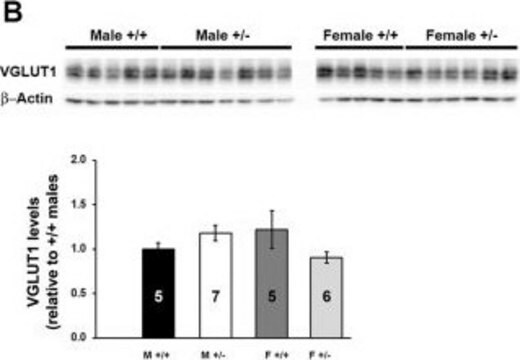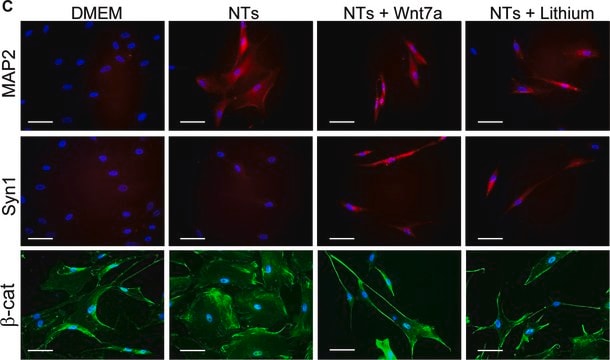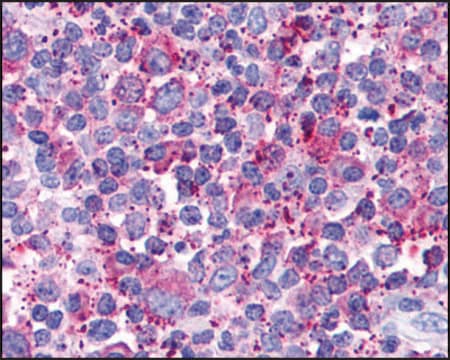AB5905
Anti-Vesicular Glutamate Transporter 1 Antibody
serum, Chemicon®
Synonim(y):
VGLUT1, BNPI
Zaloguj sięWyświetlanie cen organizacyjnych i kontraktowych
About This Item
Kod UNSPSC:
12352203
eCl@ss:
32160702
NACRES:
NA.41
Polecane produkty
pochodzenie biologiczne
guinea pig
Poziom jakości
forma przeciwciała
serum
rodzaj przeciwciała
primary antibodies
klon
polyclonal
reaktywność gatunkowa
rat
producent / nazwa handlowa
Chemicon®
metody
immunohistochemistry: suitable
numer dostępu NCBI
numer dostępu UniProt
Warunki transportu
dry ice
docelowa modyfikacja potranslacyjna
unmodified
informacje o genach
rat ... Slc17A7(116638)
Opis ogólny
Vesicular glutamate transporter 1 (VGLUT1) is encoded by the gene mapped to human chromosome 19q13. VGLUT1 is specifically expressed in neuronal cells in the brain. It is characterized with a conserved C-terminal dileucine-like motif and two polyproline domains distal to C- terminal end, including one that binds to endocytic BAR (Bin/Amphiphysin/Rvs) domain protein, endophilin.
Specyficzność
Recognizes Vesicular Glutamate Transporter 1 (VGLUT1, BNPI {Brain specific Na+ dependent inorganic phosphate cotransporter}). The antiserum has been tested on tissue sections from the rat central nervous system (CNS) using immunofluorescence histochemistry. The antiserum mainly labels nerve fibers and terminals. VGLUT1 is an excellent marker for glutamatergic nerve terminals. The staining pattern for the staining obtained with the VGLUT1 antiserum corresponds to the pattern described using other antisera to VGLUT1 (Bellocchio et al., 1998; Fremeau et al., 2001; Fujiyama et al., 2001; Sakata-Haga et al., 2001; Tong et al., 2001; Kaneko et al. 2002; Varoqui et al., 2002). Preabsorption of the VGLUT1 antiserum with immunogen peptide eliminates all immunostaining.
Immunogen
Synthetic peptide from rat VGLUT1 protein with no overlap to VGLUT2. The immunogen is available as AG208.
Zastosowanie
- Tested Applications
Immunocytochemistry Analysis: A 1:250 dilution from a representative lot detected Vesicular Glutamate Transporter 1 in rat E18 cortical cells. - Note: Actual optimal working dilutions must be determined by end user as specimens, and experimental conditions may vary with the end user
Opis wartości docelowych
62 kDa
Postać fizyczna
Guinea pig Serum in 0.1% Sodium Azide.
Informacje prawne
CHEMICON is a registered trademark of Merck KGaA, Darmstadt, Germany
Not finding the right product?
Try our Narzędzie selektora produktów.
Kod klasy składowania
10 - Combustible liquids
Klasa zagrożenia wodnego (WGK)
WGK 1
Certyfikaty analizy (CoA)
Poszukaj Certyfikaty analizy (CoA), wpisując numer partii/serii produktów. Numery serii i partii można znaleźć na etykiecie produktu po słowach „seria” lub „partia”.
Masz już ten produkt?
Dokumenty związane z niedawno zakupionymi produktami zostały zamieszczone w Bibliotece dokumentów.
Klienci oglądali również te produkty
Activation of NMDA Receptors in Lumbar Spinothalamic Cells is Required for Ejaculation.
Staudt MD, de Oliveira CV, Lehman MN, McKenna KE, Coolen LM.
Journal of Sexual Medicine null
Assignment of SLC17A6 (alias DNPI), the gene encoding brain/pancreatic islet-type Na+-dependent inorganic phosphate cotransporter to human chromosome 11p14.3
Aihara Y, et al.
Cytogenetics and Cell Genetics (2001)
Depletion of spinal 5-HT accelerates mechanosensory recovery in the deafferented rat spinal cord
Cragg JJ, et al.
Experimental Neurology, 222(2), 277-284 (2010)
Xia Chen et al.
PloS one, 6(2), e17072-e17072 (2011-03-02)
The success of transplants of neural tissue into the adult dentate gyrus in generating mature neurons is highly variable. Here we address the roles of the origin of the tissue and its pre-implantation preparation, and show that both are critical.
Lentiviral delivery of a vesicular glutamate transporter 1 (VGLUT1)-targeting short hairpin RNA vector into the mouse hippocampus impairs cognition
King MV, et al.
Neuropsychopharmacology, 39(2), 464-476 (2014)
Nasz zespół naukowców ma doświadczenie we wszystkich obszarach badań, w tym w naukach przyrodniczych, materiałoznawstwie, syntezie chemicznej, chromatografii, analityce i wielu innych dziedzinach.
Skontaktuj się z zespołem ds. pomocy technicznej












